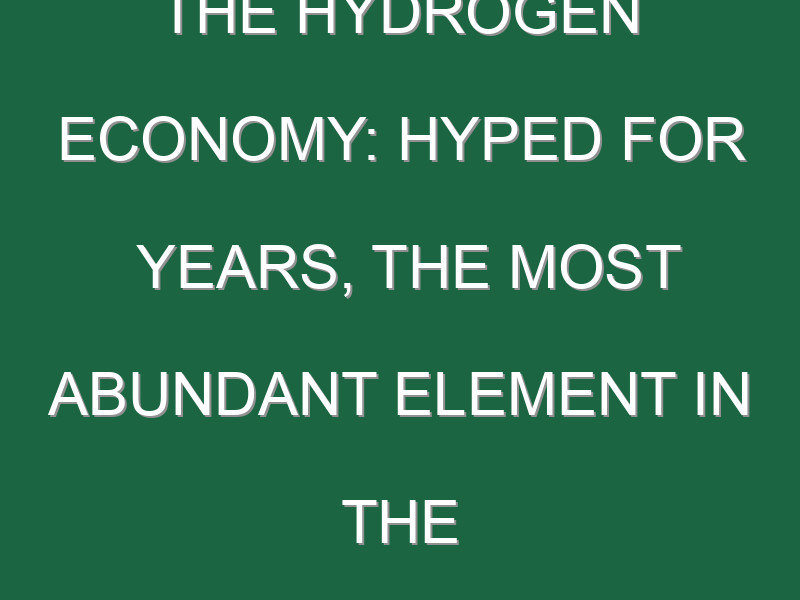Our mission to make business better is fueled by readers like you. To enjoy unlimited access to our journalism, subscribe today.
When it comes to the global energy transition, there’s one word that’s repeated so often it sometimes seems to have achieved silver-bullet status: hydrogen.
Hydrogen-powered cars, trucks and factories have been hyped for years as clean substitutes to their forebears that run on dirty fossil fuels. Better still for the planet, would be green hydrogen, which is cleaner at its source.
It’s the latter that’s getting much of the attention these days.
Just this week, the U.K. government unveiled a plan to make green hydrogen a cornerstone of its “green industrial revolution,” with £500 million ($665 million) in public funding. It’s a policy that follows similar government initiatives in Australia, France and South Korea. Companies, too, are getting on board. Earlier this month,BP and Ørsted, the Danish wind power giant, announced a joint project to create a wind-powered hydrogen plant in Germany.
It’s easy to see why there’s this rush to innovate. The most abundant element in the universe, hydrogen is viewed as a tantalizing substitute to natural gas and coal to help heavily polluting sectors such as aviation, steelmaking, and shipping de-carbonize. As an added bonus, some of the existing infrastructure in our carbon-dependent economy, from pipelines to refineries, can be retrofitted to hydrogen-based energy production.
Here’s what you need to know.
Hydrogen is not necessarily green
While hydrogen is often spoken about in the context of low-carbon fuels, it’s important to remember that hydrogen itself is not necessarily green, but only as green as how it was created.
“Right now, hydrogen is not a clean fuel, in general,” says Roman Kramarchuk, head of future energy analytics at S&P Global Platts. “You might want to think of hydrogen in the same way you think of electricity.”
To create hydrogen in the first place, abundant electricity must be used for the electrolysis process—or splitting water to create hydrogen. If that electricity comes from coal, the hydrogen itself will be far from green. It’s only green if it’s been created using renewable energy. That makes the future of green hydrogen inherently dependent on rising production of low cost, reliable energy from sources like wind and solar.
In fact, hydrogen has already been used for decades for oil or chemical refining and nearly all of it is created using fossil fuels, rather than “green” hydrogen. Currently, about 70 million metric tons of hydrogen are produced per year, according to the IEA. For context, about 4.6 billion MT of oil and gas combined was produced in 2019.
About 6% of natural gas supplies, and 2% of coal, is used to create hydrogen, according to the International Energy Agency. As a result, hydrogen is a surprisingly large source of our current emissions profile—surpassing the total emissions of the U.K. and Indonesia combined, the IEA says.
We’re a long way off
Investor momentum and government support for green hydrogen is starting from a very low base.
Wind and solar power are now so established they are competitive with fossil fuels in many markets and no longer need subsidies, but using those resources to develop hydrogen power is still, well, expensive. An analysis by BloombergNEF, the company’s research arm, put green hydrogen’s costs between $2.50/kg to $4.50/kg to make. For comparison, although the weight of a barrel of oil varies depending on the source, an average traded barrel of WTI crude is currently worth roughly $0.31/kg.
“Simply on its own, it’s not economic without a high carbon price,” penalizing its fossil fuel competitors, says Kramarchuk. “In order to really start displacing fossil fuels, it needs support.”
Analysts at Bank of America say green hydrogen prices would need to fall by 85% to be competitive with regular hydrogen, which they estimate could happen by 2030.
For that reason, green hydrogen is still only a tiny percentage of the total hydrogen production, and essentially nonexistent compared to other fuel sources. In 2019, global low-carbon hydrogen production was 0.36 metric tons per year, according to the IEA—about a half a percent of total annual hydrogen demand.
In terms of research and development, hydrogen also makes up the smallest share of any public investment area for IEA member countries. In 2019, R&D in hydrogen globally was roughly $800 million—out of $20 billion in total—less than half the amount marked out for fossil fuels.
So why is everyone so bullish?
Right now, hydrogen is high-carbon, and expensive—not exactly a promising state for a transformative, low-carbon fuel.
And yet, alongside fuel cells, which use hydrogen to produce electricity and unlike a battery does not need to be recharged, hydrogen is increasingly seen as a promising new addition to the energy puzzle. For one, it’s a promising replacement fuel for industries like shipping and aviation where it’s particularly difficult to reduce emissions. For another, green hydrogen can be produced when there is excess green power in the system—a particularly windy day, for example—and then stored for later use, helping manage the unreliable production challenge in low-carbon energy systems.
Hitting a net zero target requires using every available technology to decarbonize energy systems—and then using mitigating options or other technology to offset those emissions that are harder to eliminate. Hydrogen, like carbon-capture-and-storage, offers the chance to push those real cuts closer to an actual zero.
Also, like carbon capture and storage, hydrogen offers something else for legacy oil and gas giants: a way to repurpose their existing refining and pipeline infrastructure for a new fuel.
“There’s a number of energy incumbents that are trying to look at their own skill sets and think about what’s the best way they can be part of an energy transition,” says Kramarchuk.
Large-scale hydrogen adoption “allows them to see themselves having a role,” he added.
The result is that even if green hydrogen is coming from a low base, it’s moving quickly. The fuel is at a “pivotal moment,” according to the IEA’s executive director, Fatih Birol.
The IEA sees green hydrogen production increasing by nearly six times between 2020 and 2030 under their sustainable development scenario, and many countries—from France to South Korea to Australia—have announced national plans or investment stimulus for green hydrogen, both to cut their own emissions and to establish a head-start in what could one day be a lucrative energy export market, much like oil or gas are today.
That has resulted in some lofty predictions for the potential of hydrogen. By 2050, BofA analysts predict green hydrogen could make up 24% of our global energy needs by 2050, making it a critical fuel sources.
It’s certainly the definition of a long-term bet, which may not satisfy the green brigade, but it’s burnishing the climate-friendly reputation of plenty of politicians.
More must-read stories from Fortune:
- Will another $1,200 stimulus check ever come? Here’s what we know
- Now that Pfizer is the vaccine front-runner, should you buy the stock?
- Backlash against Jones Day, the law firm aiding Trump’s election challenge, begins to escalate
- A six-year-old Chinese electric vehicle startup is now more valuable than GM
- 2020’s 100 Fastest-Growing Companies




